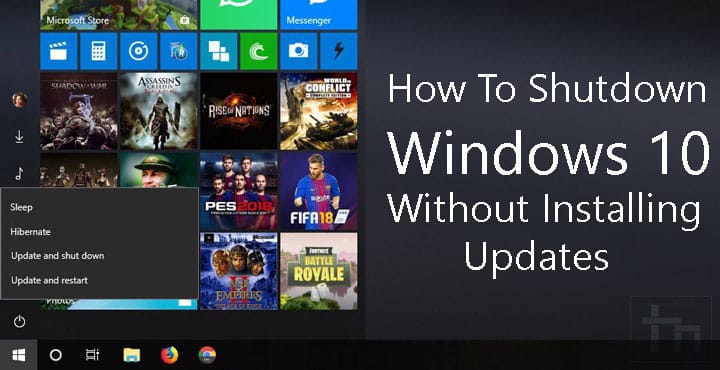How to shutdown Windows 10 without installing any Updates 1 Clear SoftwareDistribution Folder. Windows Updates downloads two types of updates. 2 Using Power Button to shut down your PC. 3 Alternatives to shutting down your computer. 4 How to disable Update and Shutdown in Windows 10. I often need to shutdown my laptop and leave quickly (lots of commuting for work). However, when an update is 'available', my only option is.
Windows 10 TweaksPressing “Windows+Pause Break” (it’s up there next to scroll lock) opens the “System” Window.Windows 10: In the new version of Windows, Explorer has a section called Quick Access. This includes your frequent folders and recent files. Explorer defaults to opening this page when you open a new window. If you’d rather open the usual This PC, with links to your drives and library folders, follow these steps:. Open a new Explorer window. Click View in the ribbon.
Click Options. Under General, next to “Open File Explorer to:” choose “This PC.”. Click OKcredit to Lifehacker. Windows 10 UpdateWell just noticed a pretty large one pop up coming in at 914MB, seems it makes some pretty serous updates.KB3172985This security update includes in the functionality of Windows 10 Version 1511 and Windows Server 2016 Technical Preview 4.
Hello our dear readers! Don’t you just hate it when Windows decides to suddenly update itself when you just want to shut down your laptop and go?
Today’s tip will help you skip updating your Windows while shutting down or restarting.Let me explain what happens:. Your computer checks for updates (in most cases, automatically). If updates are found, Windows begins to download them.
Once all the available updates are downloaded, it begins to install them one by one. After the installation is done, you computer will require a restart in order to set things up.And that’s where our trick lies. We’re going to postpone that set up and perform it when we want, not when Windows wants.


But first, don’t waste your time with these solutions you may find online – because they won’t work! Don’t try this! Here are some methods that DON’T work. Pressing ALT+F4 because the same options will be there:. Executing this command in your CMD: “ shutdown /s“, this one will only sign you out from the current user but won’t shut down your computer. We’ve included the correct command in.OK, here are the methods that do work!
Method I: Configure the power buttonWindows 10 and some older versions of Windows give you the ability to configure the power button to make it take actions of your choice. In our case, we will set it to shut down once pressed. This way, you will give your computer an order to shut down immediately without updating exactly what we want right?
So, let’s do it:. Press your Windows logo Key + R to launch your Run app and then type control panel then press Enter or click Ok. search for “power options” and choose Power Options. From the left pane, choose “ Choose what the power button does”. Change the action your computer takes When I press the power button to Shut down in both on “battery” or “plugged in” in case of a laptop.
Don’t forget to click Save changes after setting things up. Now, whenever you press the power button, your computer will shut down immediately without checking if there are updates to install or not.
Mission accomplished!P.S This is different from doing a “hard shut down” which is performed by pressing the power button down for a long time – that just shuts down everything while disregarding any running processes and it could be harmful to the computer over time. If don’t like to change what the power button does or you prefer other actions to be taken when you press it, then we have other ways, keep reading the following methods. Method II: Force shut down via CMDEveryone should know that CMD (command prompt) is our little go-to magician when we are stuck with a problem. There are several commands that you can execute to make your computer shut down and restart without a problem.
Restart Without Installing Updates Windows 10
Try it yourself:. Type “cmd” in your start menu, right-click on Command Prompt and choose Run as administrator. Click Yes to give it permission. Type the following command then press enter: shutdown /p and then press Enter. You computer should now shut down immediately without installing or processing any updates.These two methods that we went over are the best ones, and they keep your downloaded/installed updates for future processing.
If you want to remove the downloaded/installed updates for any reason, then the next method will be the best for you. Check out if you want to permanently stop your computer from downloading updates (or at least until further notice). Method III: Clear the SoftwareDistribiution download folderThe SoftwareDistribiution Download folder is the directory used by Windows to store the downloaded updates.
Windows 10 Restart Without Update 2019
You can simply delete all the files and folders there to clear any downloaded updates. Be aware that in case you need to update your Windows version, you’ll have to re-download all of these files and folders again. Now let’s go for it.